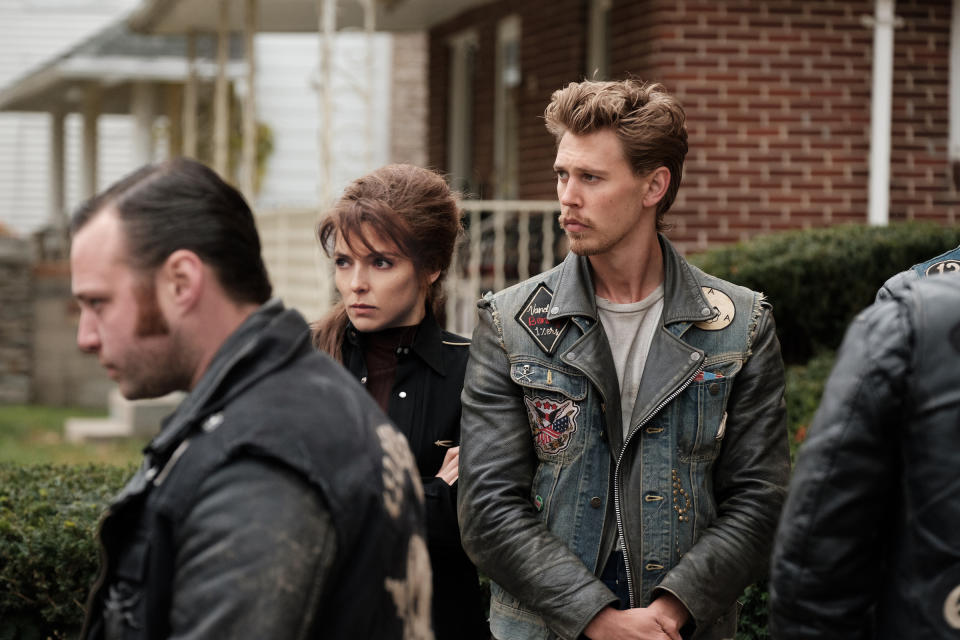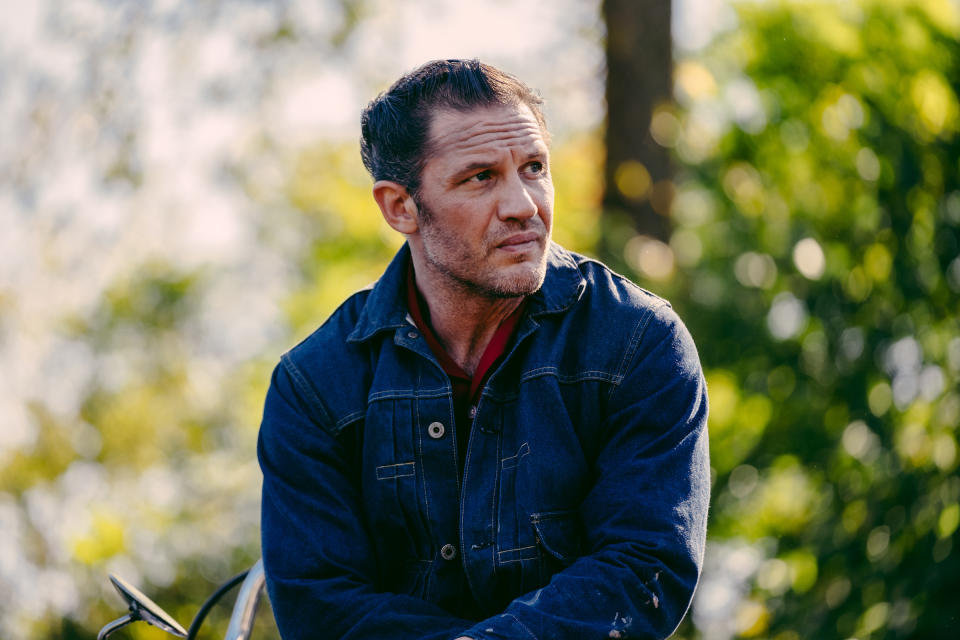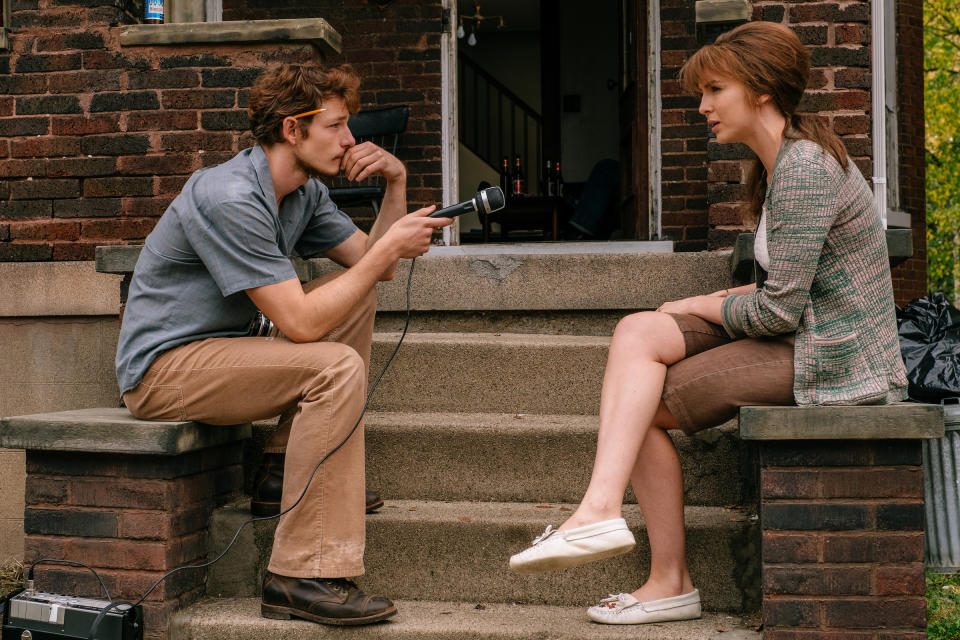The Bikeriders Saps the Vitality From Its Biker Gang Story

- Oops!Something went wrong.Please try again later.
- Oops!Something went wrong.Please try again later.
Austin Butler in <i>The Bikeriders</i> Credit - Courtesy of Focus Features
A movie that brings great still photographs to life should itself be a thing of greatness, a way of connecting us not just with a photographer’s art but with his subjects. The direct inspiration for Jeff Nichols’ The Bikeriders is the 1968 book of the same name by New Journalism photographer Danny Lyon, who spent three years chronicling the lives of the members of a Chicago motorcycle club. Lyon’s pictures—of skinny, mischievous-looking tattooed guys in leather vests, of women whose hair seems perpetually windblown, even if they’re not riding—are raw and immediate, but there’s a lilting tenderness in them too. Lyon had lived among these people, and his pictures are about as far from a clinical anthropological study as you can get; instead, he opened a portal into their lives and the things they loved best. What motivates them most is the idea of getting on a bike, sans helmet, and riding, fast; the women sometimes ride too, but mostly they just seem to adore being around these men. Lyon’s photographs, in pearlescent black-and-white, bring them to life, to the point where the images themselves seem to breathe.
So why does Nichols’ film feel so lifeless, and so listless? It features a cast of terrific, appealing actors, including Austin Butler, Jodie Comer, Tom Hardy, and Mike Faist. Shot for shot, it shows clear affection and respect for Lyon’s work, often echoing it with artisanal specificity. (The cinematographer is Adam Stone, also the DP on other Nichols movies like Take Shelter, Mud, Midnight Special, and Loving.)
Read More: Danny Lyon's Original Photos of the Bikeriders

But reverence can sap the life out of a film—that and too much acting. And boy, is there a lot of acting in The Bikeriders. The movie opens in a bar, where Butler’s Benny sits, minding his own business, until two thugs accost him. He’s wearing his club’s jacket—they’re called the Vandals—and these troublemakers strongly object. The three take the fight outside, and Benny, a lean, mean, scrapper, seems to be holding his own in this two-against-one-fight, though we find out later he hasn't gotten off so easy.
By that time, we’ve also become acquainted with the woman who fell in love with Benny at first sight, Comer’s Kathy. She pours her story out with the passionate earnestness of a Shangri-La. (That girl groups' glorious anthem “Out in the Streets” is a major feature of the movie’s soundtrack.) A scrawny, serious-looking guy, Faist's Danny, captures it all with a tape recorder. Kathy describes the evening she stepped into a scary biker joint; she doesn't like the look of these guys and tells her friend she wants to leave. “And that’s when I seen Benny, standin’ over the pool table,” she emotes emotively, before proceeding to dem, dese, and dose through nearly two hours of The Bikerider's not-so-vrooming runtime.
We learn everything about how the Vandals came to be: Hardworking truck driver Johnny (Hardy) sees The Wild One on TV and becomes entranced, as any normal human would be, with Marlon Brando. Why can’t he start a club for the guys around town who love to bike? Who love to speed down the highway with the wind in their greased-up hair, who love to commune down at the local watering hole, who really just love to feel free? It’s all very innocent, until it isn’t. These are guys who also love to fight, either to defend their turf or just for the heck of it, and Johnny, though he's one of the oldest of the gang, is one of the toughest. We see him beat the bejesus out of a guy who respectfully asks if he can start a chapter of the group in another city—only, in the end, to tell the guy that of course he can. This is pure biker logic, as laid out by Nichols (who also wrote the script), and it makes a certain kind of sense.
Read more: The 100 Best Movies of the Past 10 Decades

Until new guys come in and ruin it all. Isn’t that always the way? Nichols takes care to give each of these biker guys his moment in the sun, just as Lyon did with his photographs. We learn that the rough-around-the-edges man of few words Zipco (played by Nichols regular Michael Shannon) really wanted to go to Vietnam, though he was turned away for reasons that don’t really need explaining—you can see it all in the crazy flash of his eyes. We see, and Kathy affirms, that Johnny envies Benny; he’s also at least a little in love with him, but how could he not be? As Butler plays him, he’s a laid-back god in working men’s denim, even though we never see any of these guys work. He strides and rides through the world as if it were his for the conquering; he doesn't say much, but his penetrating gaze speaks volumes. No wonder Kathy is nuts about him, as she repeats repeatedly.
But there’s trouble in that paradise, and one of the movie’s problems is that although we’re told how much Kathy adores Benny, there are very few scenes of them together. In one, they cuddle on the bed as Benny recuperates from the surgery that’s supposed to repair his shattered foot. (That injury is the handiwork of the goons we met in the first scene.) They’re laughing at an episode of Bewitched, both in thrall to the patently wonderful ridiculousness of mid-1960s television. Then Johnny intrudes; he’s got to get Benny riding again, messed-up foot be damned. And so forth. The trials and troubles pile up, and before you know it, it’s the end of an era.
Still, we feel we’re being moved through this world as if we were experiencing the Hall of Presidents rather than stepping right into the lives of a group of wild, yet deeply human, guys and gals. Maybe the problem is outside of Nichols’ control. The faces we see in Lyon’s photographs are so resolutely self-contained that to make up a story around them feels almost sacrilegious. Everyone looks right: Comer’s hair has just the right bouffant swoop; she’s dressed in the exact synthetic stretch crepe mock-turtleneck shells we see in Lyon’s pictures. And you can’t drink in Butler’s unworried, unstudied sex appeal and not fall in love with Benny, at least a little.

But the ghost of Brando haunts The Bikeriders, and not in a good way. We can see how assiduously every one of these actors has studied and prepared; it’s as if the tenets of method acting—at least method acting as it’s commonly misunderstood—were seeping, like sweat, through their pores. That's the antithesis of the lived-in vitality we get in Lyon’s pictures. (Another problem is that the puckishly charismatic Mike Faist gets just a few minutes’ worth of screentime, sprinkled through the movie.)
Nichols is a smart, sensitive filmmaker. His 2016 film Loving is superb: Ruth Negga and Joel Edgerton play Richard and Mildred Loving, whose fight to live as a married couple spurred the 1967 Supreme Court decision that struck down laws banning interracial marriage. That film also took inspiration from great historical photography, specifically the Life magazine photos shot by Grey Villet, played by Shannon in the film. Those photos captured the Lovings’ everyday affection: the point wasn’t to make them seem exceptional, but to show just how average they were. With The Bikeriders, Nichols tries once again to open a door into the lives of people who lived before us. The romance of the streets—of being out in them, on a fast set of wheels, and of having your girlfriend wrap her arms around you once you’ve safely hopped off the bike—is all right there in Lyon’s photographs. They're complete in themselves. The Bikeriders adds color and movement and a fleshed-out backstory. And still, somehow, it feels like subtraction.
Contact us at letters@time.com.

